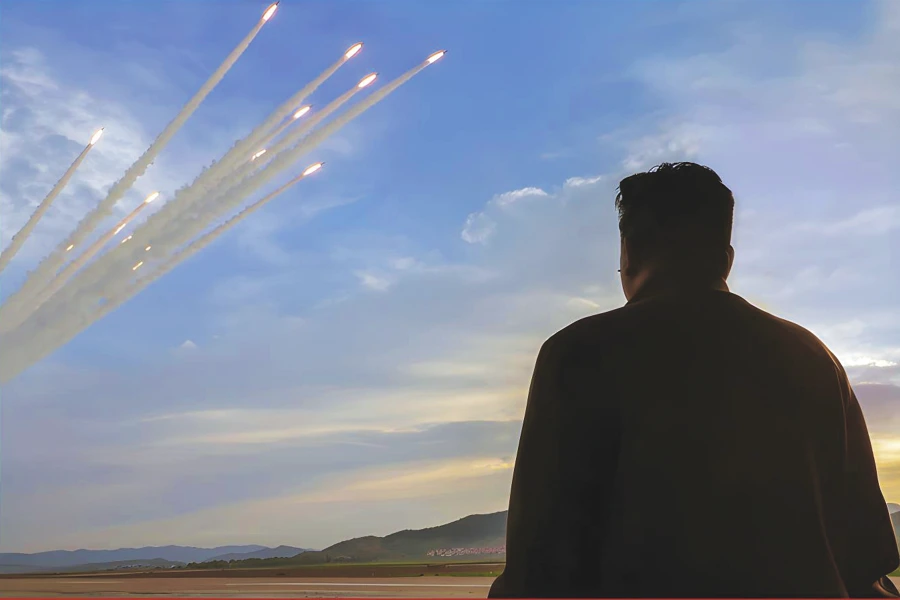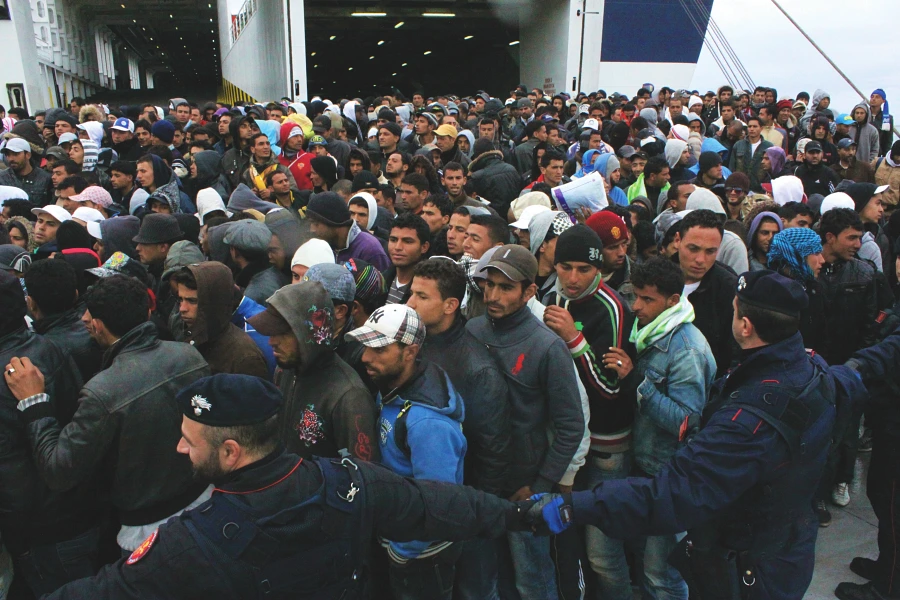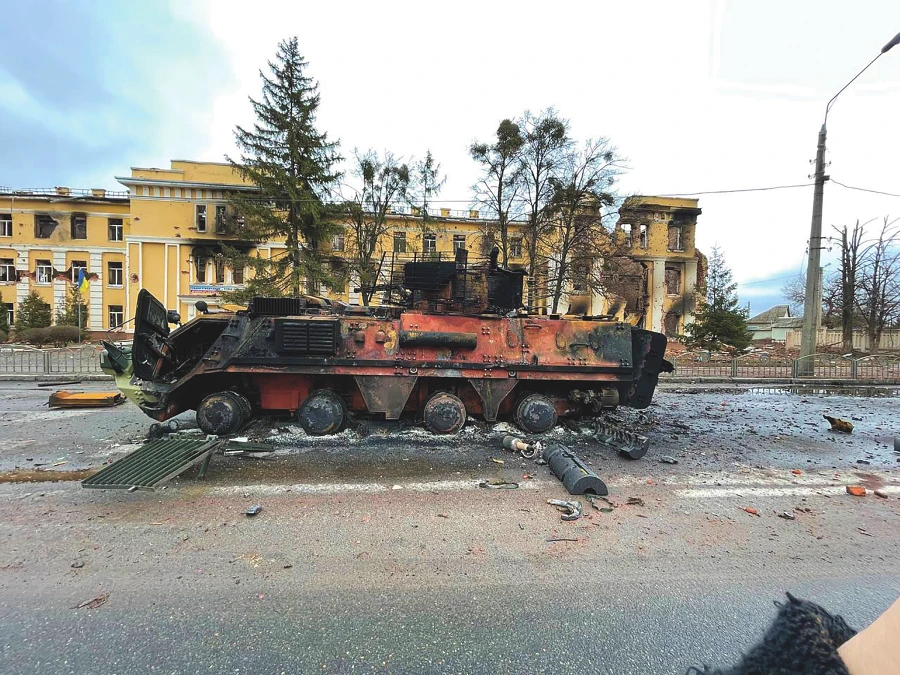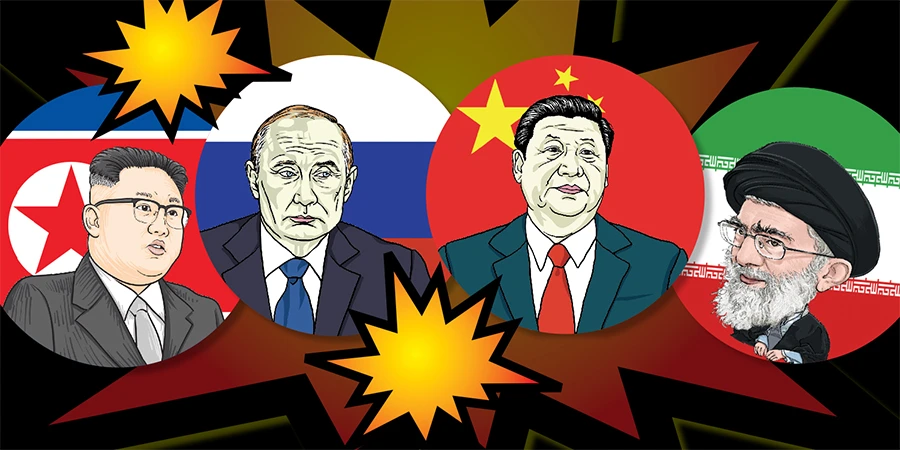For many years, Western democracies have turned a blind eye to a growing threat. They avoided confrontation at all costs and believed that concessions would appease the monster growing on the other side of the border. At every decision point, leaders of the great democracies responded to threats with feeble reactions that were interpreted – rightly so – as weakness. This policy of appeasement is what enabled the Nazis’ assault on Europe and World War II.
History, as we know, tends to repeat itself, and less than 80 years after the fall of the Third Reich, the West again faces hostile forces that threaten its way of life and even its very existence. In the last two decades, China, Russia, Iran, and North Korea have been forming a new axis to promote their interests. They have consistently exploited the freedom and openness in the West and its conflict-averse tendency.

The means in this war are diverse – ranging from influence operations and interference in Western politics to deepening societal rifts; through the deliberate influx of foreign immigrants and refugees to US and Europe on an unprecedented scale; continuing with espionage efforts and cyberattacks; to massive armament and full-scale wars against Israel and Ukraine.
This process has been reinforced by a structural difference between the parties – even without foreign interference, most Western democracies have been undergoing internal upheavals and political turmoil in recent years. As a result, democracies are forced to focus on short-term policies. At the same time, non-democratic regimes in Beijing, Moscow, and Tehran have all been free to execute a carefully planned long-term plan which led to increased collaboration.
Despite the increasing threat, the West again favors a policy of appeasement, restraint, and denial, displaying weakness and allowing the continued strengthening of the Axis at the expense of the West. All signs indicate that the probability of a new World war is increasing. To survive it, the West needs different leadership that will lead it to victory.
The New Axis
Leading the new Axis is China, the world’s second-largest economy, which under the leadership of Xi Jinping has established itself as a military and political superpower. China’s defense spending is currently estimated at around $300 billion, an 8-fold jump in 20 years. American defense spending is still several times larger, but the enormous resources China has allocated already allow it to build an infrastructure that can challenge the Americans.
In recent years, China has established a military base in Djibouti, at the entrance to the Red Sea and about 350 km from the Houthis and the port of Hodeidah that Israel recently attacked. In Cuba, 145 kilometers from Florida, the Chinese have set up a training base; and two years ago, they launched the “Fujian”, their most advanced aircraft carrier. It’s still not advanced as the nuclear-powered American carriers, but the gap is closing rapidly.
Even without foreign interference, most Western democracies have been undergoing internal upheavals and political turmoil in recent years. As a result, democracies are forced to focus on short-term policies
In the diplomatic aspect as well, China is trying to establish itself as an alternative to the Americans. One of the significant moves was recorded in March 2023, when it mediated the reconciliation agreement between Saudi Arabia and Iran. The Chinese intervened in favor of the Iranians, in the spirit of a framework agreement signed in 2021 between Iran and China, where both parties committed to comprehensive cooperation for 25 years. That agreement included a Chinese commitment to invest $400 billion in Iran.
The Saudis, Iran and China all had something to prove to the US in this move. The Saudis, who received a cold shoulder from the Biden administration, signaled to Washington that they have alternatives; the Iranians sought to contain the conflict with the Sunnis to focus on attacking Israel; while the Chinese wanted to show that there is an alternative to American diplomacy. This is a line China continues to promote: just recently, in one week in July, it hosted Palestinian delegations from Hamas and Fatah for reconciliation talks, and the next day, Ukraine’s Foreign Minister, Dmytro Kuleba, arrived in China for the first time since the war broke out.
The war in Ukraine presents both the Iranians and North Koreans with an excellent opportunity to demonstrate their value to their superior partners in the Axis. Russia needs Iranian missiles and drones, and in return got advanced Russian anti-aircraft systems and will get Sukhoi-35 fighter jets. From North Korea, Russia received a million artillery shells for the war in Ukraine, and in return, Putin visited North Korea and signed an agreement for military cooperation, which also includes a commitment to “assist” North Korea if it comes under attack.

China is also leveraging the war in Ukraine to its advantage. For the Chinese, Russia is a perfect client, as the country sanctioned by the West has no real alternative. Many Chinese companies have exploited the sanctions to become monopolies in Russia. In the short term, this gives Russia breathing room. In the long term, Russia becomes more dependent than ever on a foreign entity. In December 2023, a third of Russia’s trade was in yuan, and yuan reserves in Russia surpassed dollar reserves for the first time.
Russian dependence on China fits well into Beijing’s plan to create an alternative to the US. The Chinese are putting efforts into establishing new multinational frameworks and expanding existing ones. The BRICS forum has invited a series of countries, including Iran and Egypt; and the Shanghai Cooperation Organization (SCO) has also expanded and now includes India, Pakistan, Iran, and other countries.
The Chinese have also been working for the last 20 years to strengthen trade relations, and hence their political influence, across most of the world. The “Belt and Road Initiative”, announced about a decade ago, serves China to establish trade relations across Asia and towards Europe. Meanwhile, China has in recent years become the largest trading partner with sub-Saharan African countries as well as with the South America region, with annual trade approaching $300 billion and $500 billion, respectively. American influence in these regions is still significant, but Chinese activity is especially important for non-democratic countries. Thus, the Chinese increase their political influence and global support for a new agenda, which, even if not necessarily anti-American, is at least more balanced, with China emerging as one of the two most influential actors in the new order.
Each of the countries leading the new Axis has at least one open conflict with a Western country: Iran with its proxies is engaged in war with Israel, and Russia is fighting Ukraine; China is increasingly threatening to invade Taiwan; North Korea poses a tangible and constant threat to South Korea and Japan
Elsewhere in the Axis, the relationship between Iran and North Korea is not new – the two have been cooperating for years. North Korean knowledge aided in building Iran’s ballistic missile program in its early stages, and Pyongyang greatly assisted Iran’s proxies in the region. Hezbollah terrorists trained in North Korea, and after the Second Lebanon War in 2006, it was claimed that North Korean knowledge helped in digging bunkers in southern Lebanon. The Syrian nuclear reactor that Israel destroyed a year later was also built with North Korean assistance. In the current war in Gaza, Israeli forces encountered weapons that were manufactured in Tehran and Pyongyang and then smuggled through the Philadelphi Corridor.
Israel Under Attack
From Fake Profiles to Malicious Flower Bouquets – Iran’s Psychological Warfare Against Israel

Iranians and Russians have been operating against Israelis in cyberspace for years. One of the main stories in the April 2019 elections in Israel was the story of Iranian intelligence hacking Benny Gantz’s mobile phone. As the campaign heated up, it became clear that the Iranians also operated an army of “bots” that responded to news stories with the aim of promoting extreme content. During IDF’s Operation “Guardian of the Walls” in Gaza in 2021, yet another network of fake Iranian accounts was exposed. It ran with the intent to demoralize the Israeli public.
The new Axis countries are jointly leading an agenda competing with the West – the US, the European Union, Israel, South Korea, and Japan. Each of the countries leading the new Axis has at least one open conflict with a Western country: Iran with its proxies is engaged in war with Israel, and Russia is fighting Ukraine; China is increasingly threatening to invade Taiwan; North Korea poses a tangible and constant threat to South Korea and Japan.
Combined, the new Axis countries create a highly influential global force and a real threat to the existing world order. They operate separately and collaborate as they exploit the openness in the West and work to crumble it from within.
The Immigration Front
Every year, millions of migrants swarm the Southern border of the US and hundreds of thousands swarm the borders of the European Union. Most are just seeking a better life for themselves and their families, but among them are also hostile actors seeking to infiltrate and promote anti-Western interests. In recent years, a growing portion of these migrants are being pushed to Western borders by China and Russia.
In the case of the US, the issue of the border with Mexico was one of the central topics in Donald Trump’s first election campaign in 2016. After the number of border crossing dropped under Trump, it jumped again under the Biden administration, who rolled back some of Trump’s controversial measures. Consequentially, in the past year alone, about 2.5 million border-crossings were recorded – more than the amount recorded during all 4 years of Trump’s presidency combined. Economic and political crises in Latin America have always been a significant trigger, but Biden’s policy has been unmistakably inviting. The ever-increasing flow of migrants will be a key issue in the upcoming elections as well, especially given the fact that Kamala Harris was responsible for the administration’s policy at the Southern border.

Along with the surge in the number of migrants, there has also been a dramatic change in the places from which they originate. Traditionally, most come from the bordering countries – Mexico and its central American neighbors. Last year saw a reversal, with more than half coming from more distant countries. The three countries that recorded the biggest surge were Venezuela, Russia, and China.
Venezuela is a poor and corrupt country despite being rich in oil. Under President Maduro, it has been a close ally of Russia, China, and Iran, and all three maintain extensive ties with Maduro, who is boycotted in the West. When the Trump administration imposed sanctions and tried to pass a resolution in the Security Council against Venezuela, Russia and China responded with a double veto. The two provided loans of tens of billions to the corrupt country, from which about 7 million people – a quarter of its citizens – fled. After Trump, the Biden administration demonstrated a much more lenient policy towards migrants from Venezuela. As a result, the number of citizens of the country who reached the US border quintupled within two years.
Millions of migrants swarm the Southern border of the US and the borders of the European Union. Most are just seeking a better life, but among them are also hostile actors seeking to infiltrate and promote anti-Western interests. A growing portion of these migrants are being pushed to Western borders by China and Russia.
The phenomenon of migrants from China and Russia is interesting in itself. The number of migrants arriving from these two countries, which are of course very far from the Southern border of the US, constitutes less than 5% of the total migrants arriving at the border, but the surge in their numbers in the last two years is exceptional – the number of Chinese spiked within two years from 500 to 37,000, and the number of Russians jumped from 4,000 to 40,000. A case could be made that citizens in both countries are just looking to defect to the West, but at the same time it’s impossible to know how many of them were sent as spies. In recent decades, it has been repeatedly revealed how Russia and China are using a growing number of citizens who come to the US and live there for years as seemingly ordinary citizens, while in practice they collect sensitive information and send it back to Moscow and Beijing.
In the European Union, although the numbers are smaller, the situation seems much more threatening. In the middle of the last decade, the EU dealt with waves of illegal immigration from North Africa, and now, after several years of relative calm, there is a spike in numbers, to about 300 thousand people a year. The waves of immigration to the EU came not only from Africa but also from the Middle East. In the height of the Syrian civil war, The NATO Secretary General blamed Russia and the Assad regime for exploiting the war in order to push over a million refugees into the EU through Greece. In 2019, Turkish President Recep Tayyip Erdogan threatened to allow millions more refugees to pass through Turkey on their way to the EU if Brussels did not bear the costs of hosting the refugees in Turkey and aligned with Ankara’s policy against Syria. In this case too, the EU chose to comply. Nevertheless, over 800 thousand Syrian refugees arrived in Germany alone.
And if the stream of refugees from North Africa and Syria wasn’t enough, along came the war in Ukraine and created an immigration crisis along the Eastern border of the EU. At the end of 2021, when tensions in the region between Russia and the EU built up, Belarus, at the encouragement of the Kremlin, began sending tens of thousands of refugees from Afghanistan and Iraq to the borders of Poland, Lithuania, and Latvia, from where they easily infiltrated into the EU. In response, all three countries were forced to fortify their borders. With the outbreak of war in February 2022, masses of Ukrainians fled to the EU – according to a recent estimation, almost 4.5 million Ukrainians fled into EU countries, mostly to Germany, Poland, and the Czech Republic.
When did Churchill Become Churchill?
The man once deemed an extreme warmonger became a celebrated world leader and national hero when it was revealed he was right all along. Could it happen again?

April 10, 1940, was one of the most important days in World War II: Nazi Germany stormed France and the Low Countries – Belgium, the Netherlands, and Luxembourg. Anyone who still believed until then that Hitler would settle for less than conquering all of Europe was mistaken. On that very day, in London, a man who for almost a decade had warned and repeatedly cautioned about what was about to happen was appointed Prime Minister: Winston Churchill.
Russia didn’t stop there and opened a new front with the EU in the north, with Finland. In recent years, the Russians have been transporting refugees from the Middle East and Afghanistan to the border with Finland, allowing them to cross from there into the EU. The estimated number of crossers has surged since the war in Ukraine began, and last year was already estimated at many thousands, the vast majority of whom originated from Muslim countries. Russia is pressuring Helsinki, among other reasons, because of Finland’s joining NATO last year – a move that particularly hurt the Russians, who invaded Ukraine to prevent it from joining the North Atlantic alliance. Finland has a border of about 1,340 km with Russia, and when it joined NATO, the Russian-NATO border almost doubled overnight.
The Kremlin was furious and called the move “an attack on our national security and interests”. By chance or not, a few months after Finland joined NATO, sabotage occurred in a submarine gas pipeline and a communication cable, both running from Estonia to Finland. Immediately after the incident, Finland accused China and Russia, which had ships in the area at the time of the sabotage. Both, of course, denied any involvement. The Russians, who had already advanced S-400 anti-aircraft batteries to the Finnish border, ended a cross-border deal with Finland, triggering yet another jump in the number of refugees who crossed there into the EU. In response, the right-wing government in Finland passed a precedent-setting law that expanded the powers of the country’s border guard in an attempt to block “asylum seekers”. The newly legislated law stipulates that the border guard has the authority to repel migrants to the Russian side and to deport without right of appeal those who have already entered Finland. This is a controversial law that contradicts international conventions to which Finland is a signatory party, as well as European Union laws. It demonstrates the extents to which liberal democracies are forced to go to counter the Axis’ aggression.

Assistance to migrants has been one of the cornerstones of Western culture since World War II. But when borders are breached, and migrants enter without limit – when the vast majority are not looking to integrate but create failing cultural ghettos – it triggers a series of social processes that can only end in explosion. The welfare and economy services of the country are stretched to their limits, poverty and crime run rampant, and the locals – who feel that their country has been stolen from them – shift to the right, to parties that seek to expel the migrants and close the borders again. A straight line runs between the number of migrants in countries like Germany, France, the Netherlands, Italy, and Austria and the surge of the political right in these countries.
The chain of events seems inevitable: liberal values of brotherhood and openness lead to demographic changes of historic proportions who create social rifts. These result in chaos, which in turn pushes many towards conservatism and from there to radicalism, separatism, and a change in political priorities to deal with internal issues. It comes as little surprise then that Putin’s Russia exploits every crisis to send more and more refugees into the EU. It only needs to sit back and watch how the EU is disintegrated from within and forced to focus of domestic issues, effectively easing pressure on Russia. Despite clear evidence to the Russian actions, the EU does not exact any price from Moscow for this deliberate hostile policy.
The Virtual Front
China, Russia, and Iran were among the first countries to identify the potential in cyberspace. In each of these countries, new military units were staffed with thousands to tens of thousands of cyber and social media experts. Within a few years, their activities evolved from denial-of-service attacks to hacking systems and stealing sensitive data, to sophisticated consciousness-influencing operations.
Russian activity in recent years has promoted clear political goals against enemy governments. In 2007, Russia shut down the internet in Estonia for three weeks, in response to actions by the local government against Russia; in 2008, the Russian assault on Georgia also included a cyber-attack on the country’s communication infrastructure; in 2009, rapprochement between Kyrgyzstan and the US triggered a wide-scale outage in one of the country’s largest internet providers; in 2014, the Russians attacked the computers of the Central Election Commission in Ukraine, a few days before the elections; and in 2015, the German government detected a massive Russian infiltration into its computer infrastructure, including in Chancellor Merkel’s office. Ahead of the 2016 elections in the US, Russian elements hacked into computers related to Hillary Clinton’s campaign.
In the summer of 2023, American intelligence revealed how, as part of Russian disruption efforts against arms supplies to Ukraine, experts on behalf of the Kremlin tracked about 1,200 employees of two large weapons manufacturers in Germany on social networks and marked for recruitment workers who demonstrated anti-Western or anti-government attitudes.
It seems that every time legitimate disputes arise in the West, interested parties take care to pour oil on the fire. Woke protests in the US – What began as liberal left activity for social justice and against racism – quickly turned into a wave of radical and progressive movements that provoke a backlash in conservative circles
Russia is not alone – the Iranians and Chinese are also stirring in this cauldron, and recently Microsoft reported on Iranian meddling in the US 2024 elections through hacking into computers at Trump’s HQ.
Chinese espionage activity against the West in general and the US in particular is much more dramatic. In 2015, the National Security Agency (NSA) published a map of 700 American institutions that were hacked by Chinese actors. Among the notable targets: leading weapons manufacturers who build the most advanced American weapons systems, NASA satellites, and more. Britain, Germany, and France also fell victim to Chinese cyber-attacks and espionage, including countless incidents where government servers were breached. In Israel, Rafael, Elbit Systems, and Israel Aerospace Industries were reportedly hacked by Chinese actors, and code related to the Iron Dome and Arrow 3 programs was suspected to have been stolen.
From attacks and espionage, China, Russia, and Iran have moved to influence operations aimed at radicalizing the public discourse and disintegrating Western societies from within. In 2020 alone, the social network X (formerly Twitter) closed about 170 thousand accounts related to influence operations led by the Chinese. Meta (formerly Facebook) has also disabled hundreds of thousands of accounts related to foreign activity in recent years.

It seems that every time legitimate disputes arise in the West in general and in the US in particular, interested parties take care to pour oil on the fire. Woke protests in the US, a collective term for social movements that have gained momentum in recent years, are a central target for this activity. What began as liberal left activity for social justice and against racism quickly turned into a wave of radical and progressive movements that provoke a backlash in conservative circles. This struggle has caused a rapid and dangerous radicalization in public discourse in the US, with enemies of the West are working to radicalize the discourse even further.
Every struggle or social protest needs money, a lot of money, to fund the activity and expand the protest. Organizing rallies, advertising, sound equipment, campaigns on streets and social networks, etc. – all this requires significant capital. While the protesters themselves in the vast majority of cases – in Europe, the US, and also in Israel – are concerned citizens who have the country’s best interests in mind and take to the streets to protest or demand change, they are not always picky about the source of money donated to fund the activity, and are unaware of the forces behind the bodies that donate to them, which also disguise themselves well. On the other hand, those foreign donors pour money not necessarily because they have any special interest in promoting the protesters’ goals – they just want to fuel social unrest and political rifts.
For example, in the riots that broke out after George Floyd’s murder, activity was observed in Russian, Chinese, and Iranian accounts that echoed messages against the American establishment and painted the entire US as a racist country. In the uproar surrounding the storming of the Capitol and Trump’s possibly blame in the matter, there was a surge in posts dealing with it from fake Russian and Chinese accounts.
The anti-Semitic protest against Israel in US universities in many cases was organized by the same radical organizations that promoted controversial agendas. In early July, American intelligence warned that Iran is encouraging and funding many of these demonstrations in the US through social media activity. The intel did little to convince protestors to back down.
In the political arena, the 2016 US presidential election was the first significant event in which Russian involvement was claimed – tens of thousands of fake accounts spread content that promoted Russia’s interests. Meta estimated that within just two years, no less than 126 million Americans were exposed to content published and promoted by Russian media activists on its platform alone.
One of the effective tools for influence operations has been running fake news sites. In June 2021, the US administration announced that it had ceased control over 36 fake news sites all linked to Iran, including three sites operated by Hezbollah. In May 2022, three months after the Russian invasion of Ukraine, a European research organization uncovered a Russian disinformation campaign dubbed “Doppelgänger” (German for “double”), a sophisticated influence operation that included replication of existing and well-known news sites such as The Washington Post, Fox News, and Der Spiegel. In June, against the background of the parliamentary elections in France, authorities accused Russia of a similar doppelgänger campaign in an attempt to influence the discourse and election results in the country.
The Russian campaign promotes clear messages: sanctions against Russia don’t work, Western countries hate Russia, Ukrainians are motivated by Nazi ideology, and the absorption of Ukrainian refugees in Europe will lead to disaster for the continent. The effort includes not only fake news sites, but also fueling discourse by echoing messages from extreme right-wing elements and known conspirators on one side, and extreme left-wing elements on the other.
Since the October 7 attack, Israel has also joined the Russian target bank and fake sites of Walla and Mako published news against Israel, including a deep-fake of IDF spokesperson Daniel Hagari inviting Ukrainians to join the IDF in exchange for Israeli citizenship. A significant part of the fakes blaming Israel for war crimes in Gaza, was actually manufactured by Russia and Iran.
The Flexible Morality of the West
The West struggles to uphold its own moral principles, as political and economic interests clash with moral ideals

Since World War II, the West, led by the U.S., has consistently led efforts to formulate international conventions that defined a moral and legal framework for the laws of war. The original idea to set universal rules of war and hold accountable those who violated them was a logical conclusion from the horrors of the world wars.
In France, a month into the war in Gaza, Jewish homes across the country were marked with a Star of David. Many assumed it was an action by Muslims, but it quickly became clear that pro-Russian elements were behind the action. In Britain, it was reported that Russia, along with China, has been working since the start of the war to provoke controversy in British public opinion by promoting pro-Palestinian influencers. Recently, Britain was swept by a wave of riots between Muslims and far-right activists – right-wing people took to the streets after a terrorist act in which 3 girls were stabbed to death and others were injured. The police initially refrained from publishing the identity of the perpetrator. Rumors quickly spread on social media that it was a Muslim immigrant who had infiltrated Britain. It later turned out to be a native of Wales, son of Christian immigrants from Africa. In Australia, Iranian agents were arrested for encouraging demonstrations and protests. And the list goes on and on.
And there is of course TikTok, which has become the ultimate platform of the Chinese government for inflaming controversies and spreading messages in the West, especially in the US. A significant part of the extreme discourse on networks is fueled by TikTok’s algorithm, which overwhelms young people in the US with anti-Semitic and anti-establishment content. The Trump administration issued a presidential order designed to force TikTok to sell its US operations to an American company, or risk being blocked. In June 2021, shortly after taking office, Biden rescinded the order and replaced it with a new order that called for the Commerce Department to launch a review of foreign-controlled apps that could pose a risk to American interests. Only in April 2024, against the background of uncontrollable protests in the US and pressure from Congress, a law was passed again that requires the Chinese company ByteDance to sell TikTok by January 2025, or it will be blocked in the US.
The Military Front
While the Axis countries attack, the West – especially the US – is reluctant to respond. The American military record since the beginning of the century has not been impressive, to say the least. Sinking into the quagmire in Iraq and Afghanistan has led to an aversion from military interventions at almost any cost, which in turn has eroded American deterrence to the bone.
The US is projecting weakness. Obama threatened Assad that the use of chemical weapons would have “serious consequences” – but did not ordered a significant response when these weapons were used; when the Iranians captured American Navy sailors who accidentally entered Iranian waters and broadcasted humiliating pictures of the American troops, it passed without response; the hasty pullout from Afghanistan abandoned local allies and left valuable American military equipment in the hands of the Taliban; and even after October 7 and Biden’s famous “Don’t” speech, Iranian militias attacked American forces in Iraq and Syria dozens of times and were met with symbolic responses for months. In each of these cases, the world’s greatest superpower bent over backwards to avoid confrontation, for a price that on the surface did not seem dramatic. But the world is always watching and drawing conclusions.

The US is responsible for more than a third of global defense spending. Americans spend more than the next ten countries combined, including China and Russia. They may prefer to use their military power for deterrence only, but their rivals typically interpret restraint as weakness. This behavior consistently raises the confidence of China, Russia, and Iran and their audacity increases accordingly.
Over the past year, Russia has begun to actively operate throughout Europe to disrupt arms supplies to Ukraine – arson of warehouses in England and Germany and sabotage operations in Poland, Lithuania, Latvia, the Czech Republic, and France, have all been attributed to the Russians. One of the main targets in the Russian campaign is Germany’s Rheinmetall, a major arms supplier to Ukraine. Rheinmetall CEO Armin Papperger himself became a target and part of his house was set on fire, in an action also attributed to Russia.
In the Chinese context, the best barometer for the level of confidence they feel is their attitude towards Taiwan. The Republic of China is a free democracy and a technological powerhouse, with a strong army equipped with the best American weapons. Sounds familiar? For both the Axis and the US, Taiwan is another arena in the global struggle. When the US administration transferred emergency aid to Israel and Ukraine a few months ago, Taiwan was also on the list, and for good reason – Communist China does not hide its aspiration to take over the island and unite the Chinese people under the red flag.
A Chinese offensive against Taiwan, if and when, will open a third front in the world war unfolding before us. It will change the world order dramatically over night – world trade will be disrupted and a new iron curtain will be all but official. From Beijing’s perspective, this would be an all-in move whose long-term implications are difficult to predict. This is why a risk-averse regime like the Chinese has refrained so far from making this move, despite making no secret of its aspirations. There is no telling when it would cross the Rubicon.
China has long not limited itself only to East Asia – on February 1, 2023, a Chinese spy balloon was spotted for the first time in the skies of the United States and Canada. The balloon made its way slowly across the entire continental US, until it was intercepted over the Atlantic Ocean 3 days later by an F-22 aircraft. The Chinese claimed it was a meteorological research balloon that drifted off course, but the Americans insisted it carried espionage equipment. Biden administration officials even claimed that the balloon was part of a fleet of balloons spotted over at least 40 countries. Analysis of the balloon’s remains revealed that while it was floating, it used public American internet services to send information back to its operators.
The American behavior raises the confidence of China, Russia, and Iran and their audacity increases accordingly. Over the past year, Russia has begun to actively operate throughout Europe to disrupt arms supplies to Ukraine – arson of warehouses in England and Germany and sabotage operations in Poland, Lithuania, Latvia, the Czech Republic, and France
On July 25 this year, the North American Aerospace Defense Command spotted two Russian bombers and two Chinese bombers flying side by side in Alaska’s Air Defense Identification Zone (ADIZ), about 200 miles from the coast. The Americans scrambled planes towards them in response. The Chinese claimed it was a joint strategic air patrol in the airspace of the Bering Sea, which passes between eastern Russia and western Alaska.
This is not the first time Russia has sent planes to Alaska’s ADIZ – just last May the Russians sent four planes to the area. However, this is the first time Chinese bombers have been spotted in the area. Their appearance, alongside Russian bombers, was intended to send a double message to the US – Beijing is capable of sending forces anywhere in the world; and it will not be coming alone.
The West’s Response
The countries of the Axis continuously go after the West. Even though damages caused by the flow of migrants, cyber-attacks, and influence operations campaigns could be no less destructive than direct fire, the West does not mobilize for war. Thus, the aggressors remain free to do as they please and increase the pressure. The price they will pay, if at all, will be negligible.
The cure is almost self-evident – the immediate thing needed is to stem the flow of refugees. In Europe, they have managed to reduce their numbers in recent years, but tens of thousands are still entering. Deportation of illegal immigrants and acting against each violet crimes are essential for reducing the economic burden and restoring personal security. This sounds trivial, but few governments are working to do this today. Many in the liberal camps in the West believe welcoming migrants with open arms is a part of their identity. They perceive any restrictions as an attack on democracy.
In the virtual space, it is much harder to close the borders, particularly in democratic countries. Still, there is something to be done. Imposing comprehensive, and especially swift, sanctions on any hostile activity, blocking TikTok and regulating the field, can pressure all social networks to invest and come up with new ways to circumvent disinformation campaigns. Finally, educational activities should be expanded to raise awareness of online manipulations from a young age – in some Scandinavian countries, such programs are already operating in schools with great success.

And what about offensive activity? The West certainly won’t make cynical use of refugees to pressure foreign countries. Influence operations are also much more difficult to execute in a country without free media. In authoritarian countries like China, Russia, and certainly Iran and the totalitarian North Korea, influence operations could come to the attention of the public in the West only in exceptional cases.
Therefore, exerting direct pressure is the most logical path. Actions of disruptive nature, including offensive cyber and economic sanctions, are the two most popular tools in the Western arsenal.
In the cyber dimension, the most lethal and famous attack was Stuxnet, the sophisticated computer worm that in 2010 caused enormous damage to Iranian nuclear centrifuges. That operation was claimed to be carried out by Israel with American assistance. Since then, over the years, various reports have been published about Mossad’s disruption activities against the nuclear program in Iran – from nuclear scientists who met their deaths in various ways to military facilities that mysteriously caught fire.
In August 2023, the Iranians announced that they had thwarted an “Israeli plot to sabotage missiles and plant defective components in them”. In practice, with or without outside help, American sources reported after the Iranian attack on Israel in April that a few dozens of the hundred missiles launched by Iran failed shortly after the launch or disintegrated in space.
In response to espionage accusations, the US banned the use of equipment from the Chinese telecom giant HUAWEI. Britain and Germany have since made decisions to completely ban the use of Chinese companies’ equipment in 5G cellular networks, following evidence they were used for espionage. The European Union encourages, but still does not require, all its members to avoid using Chinese communication devices, and these have indeed been replaced or not included in the building of new networks. These steps do not prevent, but at least block one espionage route, terrifyingly easy, which the Chinese used.
Economic sanctions at the national level can be no less effective, especially towards countries that invest heavily in offensive activities against the West. The sanctions on Russia following the first invasion of Ukraine in 2014 ended a decade and a half of rapid growth in Russia. Mounting sanctions in response to the invasion in 2022 deepened the impact on Russian GDP. The Russian economy has recently returned to growth thanks to trade with China and Iran, but even so, according to IMF estimates, it is expected to return only in 2029 to the GDP level it had on the eve of the war in 2014.
Western sanctions on Iran weighed heavily on Tehran in the previous decade – Iran’s GDP plummeted from $625 billion in 2011 to $195 billion in 2020. With the signing of the Nuclear deal, most sanctions were lifted in 2016 and the UN arms embargo expired on October 2020. Iran’s GDP doubled in the last 3 years and its current trajectory would put it back to $600 billion area by the end of the decade.
If the West is planning to impose sanctions again, it should remember that these can only be effective if they are comprehensive and prolonged. The worst thing that can be done, as was done in recent years, is to lift the sanctions without an alternative measure to make sure Iran complies with its obligations.
Breaking Out of the Conception
At the strategic level, the US’s handling as the leader of the free world with China, Russia, and other Axis countries can be compared to Israel’s regional war with Iran and its proxies. The conception among the Israeli leadership, like the policy of appeasement, led to self-denial and containment of growing threats for years. This is the dynamic that allowed Hamas to strengthen and led Israel to October 7. This is exactly the chain of events that allowed Iran to surround Israel with heavily armed terrorist armies.
On the global stage, Western countries turning a blind eye to the activities of China, Russia, Iran, and North Korea face a crisis not seen since World War II. As with Israel and Iran, America’s greatest adversary is China, and the struggle with it will determine the fate of the entire campaign. However, there is still a long way to go before direct confrontation. There is an opportunity to act against China’s allies, to change the equation in favor of the West and throw the rival bloc off balance.
Just as the wars against Ukraine and Israel directly and indirectly challenge Western interests, a Western attack on one of the prominent countries in the new Axis could undermine it and weaken its stance in all other regions. Direct confrontation with Iran, the only non-Nuclear country of the 4 leaders of the Axis – has been and remains the key to strategic change in favor of the West. Toppling the Ayatollah regime would dramatically change the balance of power in the Middle East in favor of pro-Western countries and dramatically harm Russian and Chinese interests. Of course, this is also an Israeli interest, but not only – nuclearization is the ultimate insurance policy and if Iran gets its hands on a bomb, not only the region but the entire world would be put at risk.
No less important, a major war can be an opportunity to unite the ranks in the West – like on October 7, a sense of clear and immediate threat will eliminate internal disputes, at least for a while, and remind the sane majority who the real enemy is and how important it is to stand up to it.
The historic victory in the Cold War left the West as the ruler of the world and without a clear enemy. In the US and Europe, a liberal agenda and an idealistic worldview were adopted. On paper, it sounds ideal, but in practice, it led to complete chaos. Two decades of turning a blind eye allowed China and Russia to recover and place the entire West under the greatest threat since the mid-20th century. Now, if the West wants to survive, it seems it has only one option left: prepare for war.
The author is a Ph.D. in International Relations, a researcher and writer on the Israeli and global geopolitical arena





